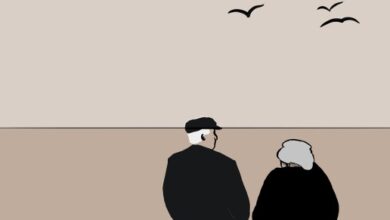“The Facts in the Case of M. Valdemar” is a proto-science fiction short story by American author Edgar Allan Poe. Published in 1845 in the American Review and the Broadway Journal simultaneously, Poe employs gothic elements to induce feelings of horror and disgust in the audience. The story is often considered to be one of the earliest examples of what later developed into the genre of science fiction in English literature.
The Facts in the Case of M. Valdemar | Summary
Written in first-person narrative with a narrator whose identity is not disclosed, identified only as Mr. P in the story, the narration begins a few months after the death of M. Valdemar, which the narrator intends to bring to light the actual facts of the case which has apparently caused a scandalous uproar in public. Around three years preceding the actual action of the story, the narrator informs us, that he had suddenly developed an interest in the pseudoscientific method of Mesmerism, a precursor to modern hypnotism. Around nine months prior to the writing of this story however, it dawns on him that there has been no precedence of attempting to put a dying person in a mesmeric trance in articulo mortis i.e., at the moment of death. His curiosity peaks at the thought of witnessing whether, at the moment of death, any susceptibility towards magnetic influence might exist, and if it does exist, does the patient’s physical condition aid or hamper the trance-like state, and finally, for how long might death be arrested or deferred in the mesmerized condition.
The narrator chooses as a subject of his experiment his friend, Earnest Valdemar, a renowned author, and compiler who, apart from being a willing subject to P’s previous mesmeric experiments, has also been recently diagnosed with terminal tuberculosis and certified to die in the near future. The reader is told that Valdemar has a particularly nervous temperament which makes him a good candidate for the narrator’s experiments. However, while he encounters no difficulty in ‘putting him to sleep’, he is barely able to control Valdemar’s will even under the mesmeric influence and is even unsuccessful in establishing clairvoyant connections with Valdemar.
Regarding his rapidly approaching end, Valdemar seems rather calm and accepting, and excitedly consents to the narrator’s proposal, which surprises P, since Valdemar, although never unwilling, has never appeared to be truly interested in or sympathetic towards his antics. Given the nature of Valdemar’s illness which allowed physicians to predict the exact moment of his death, the two come to a decision that Valdemar would inform P twenty-four hours prior to that fated hour. Upon receiving the note a couple of months later, the narrator rushes to his residence to find Valdemar bedridden and dying. In ten days since their last meeting, his physical condition seemed to have deteriorated drastically, the disease progressing with an unanticipated rapidity. An ashy face, lustreless eyes, severe weight loss, and a barely perceptible pulse seemed to signify a man in the final hours of his life. He did, however, retain a considerable degree of mental prowess and strength enough to take his medicines unassisted.
P is briefed on Valdemar’s current health condition by the two doctors in attendance – Dr. D and Dr. F, who inform him that his left lung has partially turned into bone and cartilage for the last eighteen months, and is completely non-functional, while the top half of the right has also begun to ossify i.e., turn into bone, while the bottom half is full of pus-filled tubercles or noduled lesions inside the lung, with a section of it permanently joining the ribs in a state of ossification. There has also been an aneurysm of the aorta i.e., the primary artery of the body that supplies oxygenated blood to the respiratory and circulatory system, all signs pointing towards a painful, impending death. After obtaining consent from both the doctors and the patient on his proposed mesmerizing experiment, they agreed to commence from eight pm the next evening, in the presence of a witness in the form of a medical student, Theodore L.
The next evening on the time agreed upon, the narrator begins the process of Mesmerism. While he found no difficulty in subduing Valdemar, no further progress was observed for the next two hours despite consistent efforts on the narrator’s part. At this point, P changes his hand movements, while his subject’s breathing is noisy and labored, his pulse, is imperceptible. Half an hour later, Valdemar sighs, and his breathing returns to its slow, normal rate, no longer struggling for breath, his limbs as cold as those of a corpse. Around eleven, signs of mesmeric influence begin to show, with the subject exhibiting a trance-like state similar to sleepwalking. The narrator continues with his manipulations until his limbs and body are still, placed in a comfortable position, when he is re-examined by the doctors. Three hours later, his condition remains unchanged, with signs of life still present.
This time, P. attempts to control Valdemar’s will in an effort to move his limbs and succeeds easily, a feat that he had never achieved before. He asks him if he is asleep, and receives no answer except a slight movement of his lips. Upon repeating the question thrice, he receives a faint, whispery answer –
“Yes; —asleep now. Do not wake me! —let me die so!”
Upon further questioning, Valdemar asserts that he is not in pain, and they decide to leave him undisturbed until the moment of death. The next morning, his condition is unchanged. However, upon being questioned whether he is still asleep, Valdemar’s body undergoes a marked transformation, showing grotesque but unmistakable signs of death, repelling all who surround him.
As the doctors and everyone present were preparing to certify him as dead, however, an unmistakable vibration was observed in the tongue, followed by a proclamation by an inhuman voice – a voice that seemed to be originating from far away, and had an eery, gelatinous quality to it like no human voice ever did, certifying the death of its own body and causing one of the witnesses to faint. No sign of life was found upon further inspection; barring the movement of the tongue, the body appeared to be dead with no observable change in this condition on the following day. Concluding that they have successfully arrested Valdemar’s death through mesmerization, the doctors and the narrator agree to not wake him up from his trance, certain that he will die the instant he wakes up. Leaving his body in this condition for seven months, they decide to finally awaken him. On the fated day, P begins the process of breaking the trance, followed by the first signs of awakening – a movement of the iris followed by a pus-like, extremely pungent discharge. On asked Valdemar what course of action he desires, a response is received –
“For God’s sake!—quick!—quick!—put me to sleep—or, quick!—waken me!—quick!—I say to you that I am dead!”
Unnerved, P decides to awaken him completely, leading to the horrifying, grotesque, and disgusting culmination of the story- the active decomposition of his body that had been arrested for the last seven months, taking place in front of the eyes of all present in a few instants till there remained nothing more than a rotting mass of liquidy substance on the bed.
The Facts in the Case of M. Valdemar | Analysis
Written with the use of the first-person narrative voice, Poe extensively uses the gothic elements of gore, grotesque, fear, and disgust in this story. The narrative structure, with the vague description of a scandalous death at the very beginning, with the details or manner of the death disclosed slowly as the story progresses, also works to create suspense and tension in the audience, much like Poe’s detective fiction, a genre that he is credited with the creation of. The story is also narrated in a detailed, objective manner, with numerous scientific and medical details, that gives it the appearance of a true story rather than fiction.
The fact that all the characters’ names, with the exception of Valdemar, remain undisclosed, also strengthens this appearance of the story being based on a real incident, as does the narrator’s introduction that begins with the claim of correcting all the scandalous and misrepresented details of the case that have caused an uproar in society. Structurally then, the story represents an amalgamation of techniques used in detective fiction, and science fiction, with the ending using strong emphasis on elements of horror and the grotesque.
The message that comes through at the end of the story remains clear and undisputable- it is never advisable to attempt to interfere with the process of mortality which is natural and inevitable. Such experiments go against the laws of nature and will certainly yield undesirable, disgusting, and potentially dangerous results. Poe displays an attitude of skepticism and apprehension toward the steady progress of science which was not uncommon in the early nineteenth century, although his detailed knowledge and understanding of the science of the human body here is fascinating, portrayed in the carefully crafted detailing of Valdemar’s rapidly deteriorating respiratory condition, as well as the decomposing state of his body.
Arguably the most interesting philosophical issue that the story raises is the distinction between the body and the soul. Even as Valdemar’s body dies, his soul exists, remaining in the trance-like state that he was put in while alive, the tongue, being the medium of expression of the soul, attempting to move and speak within dead, motionless jaws. This makes the reader speculate on Poe’s position regarding the centuries-old debate on the immortality of the soul as opposed to the mortality of the body.


